Morning Refuge 1/3

(Click images to enlarge, click again to zoom.)
In the near-dark, Common Gallinules were gabbling and the calls of distant gulls confirmed we were near the coast. Weather reporters, excuse me, nowadays they prefer to be known as “Climate Experts”, advised it would be chilly and nearly calm this morning. “Chilly” to a native Floridian is below 70 F/21 C. The prediction of 42 F/5.5 C was accurate. The wind was ripping at 15-20 MPH. Not “calm”. Result = Cold Couple.
Gini and I made the cross-state drive to visit Merritt Island National Wildlife Refuge (MINWR)* in the hopes of seeing a few migratory birds and to enjoy the diverse habitat found within this very special place. Thanks to Gini’s prowess in smashing alarm clocks, we were able to sneak by the Land of the Mouse and the neighboring neon lights of Orlando’s associated venues designed to attract tourists as so many moths to the flames of eternal entertainment. (Why are all those lights burning at 0500?) There was plenty of traffic, but it was headed into Orlando as we were exiting the metropolitan morass.
Our trip occurred on January 30, 2024. It’s hard to believe we’re finished with the first month of our brand new year.
MINWR was established in the early 1960’s from land which had been acquired to support the mission of the National Aeronautics and Space Administration (NASA). As development of the Cape Canaveral launch complex proceeded, the southern portion of the area was set aside for a wildlife refuge. Today, more than 140,000 acres is managed for the protection of a myriad of natural resources. It’s a great place to visit any time of year but the vast amount of marsh, fresh and salt water as well as beach front is especially attractive to migrating waterfowl.
Sunrise. Just prior to dawn, the eastern sky displays an amazing variety of subtle hues. As the sun breaks above the horizon, its amazing brilliance takes your breath away. Golden light paints a picture of a perfect day waiting to be explored.
After enjoying a cold, but rewarding visit to Gator Creek to watch the dawn spectacle, Gini and I headed to Black Point Wildlife Drive. This is a seven-mile one-way trip through shallow water marsh impoundments and pine flatwoods.
There will be three posts describing our visit. Hope you enjoy it a fraction as much as we did.
We enjoyed watching the sky being painted with pastel layers just prior to sunrise. The building near the center of the image is NASA’s Vehicle Assembly Building.
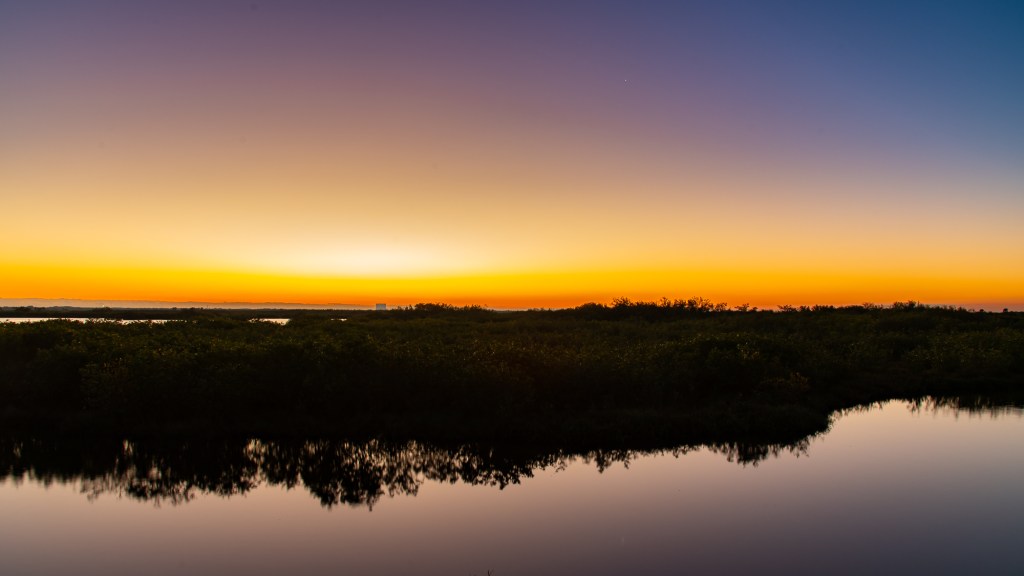
Don’t forget to turn around when enjoying a sunrise. This is the edge of Gator Creek where we were standing to watch the dawn. The creek is an inlet of the Indian River. The moon was a bonus.

A pod of three Bottlenose Dolphins hunted in the creek as the Sun pointed out where to find the fish.
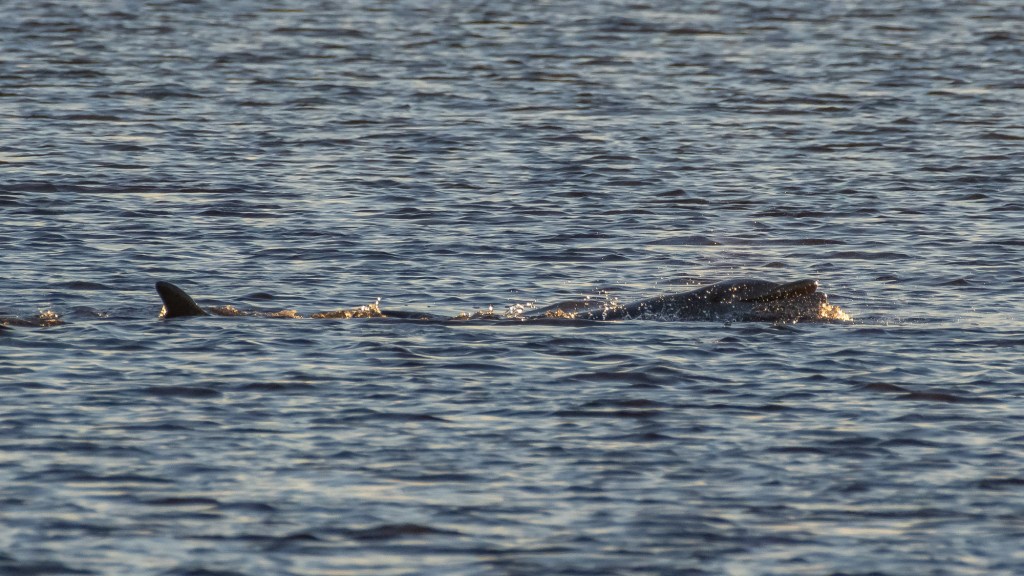
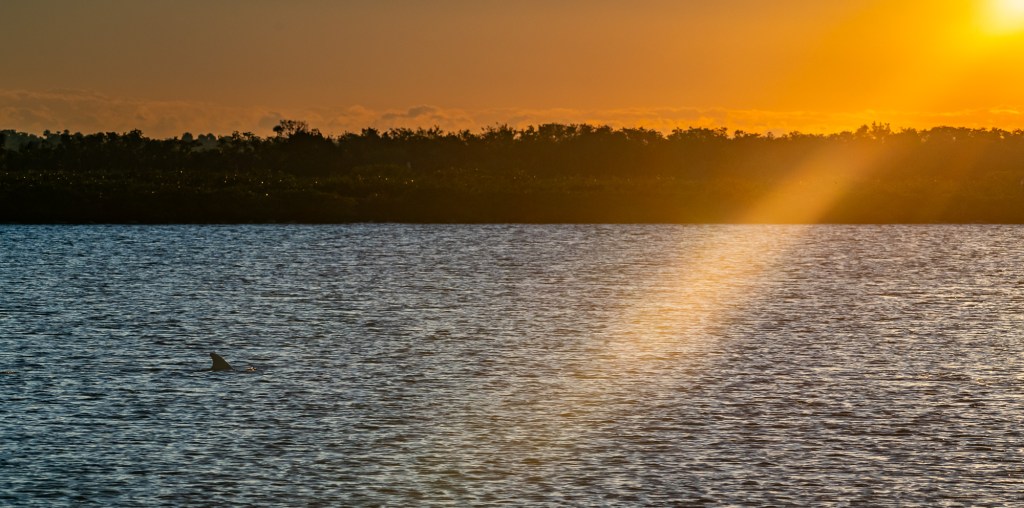
The dawn’s early light gives a Tricolored Heron a special glow. I’m not sure he’s ready to be up just yet as the stiff breeze ruffles his head feathers.
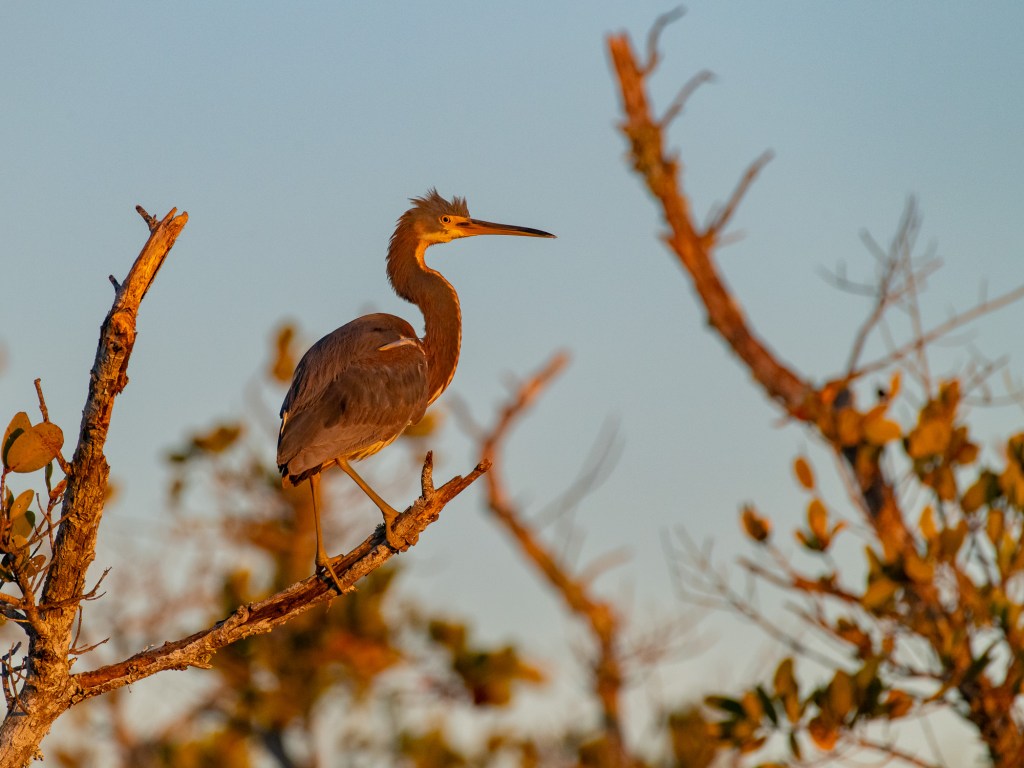
As we entered Black Point Wildlife Drive, it looked quite different than when we visited about a year ago. (First image now, second then.)
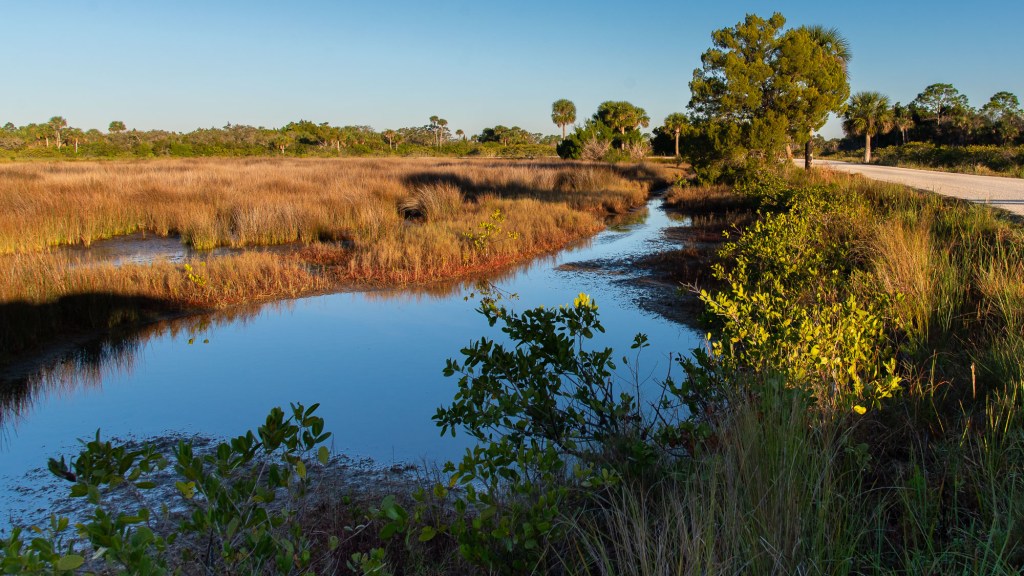

January. Wildflowers. Pleasantly surprised. Indian Blanket (Gaillardia pulchella).

Typical marsh habitat. Among all that grass are pockets of water where all sorts of water-loving birds can hide.
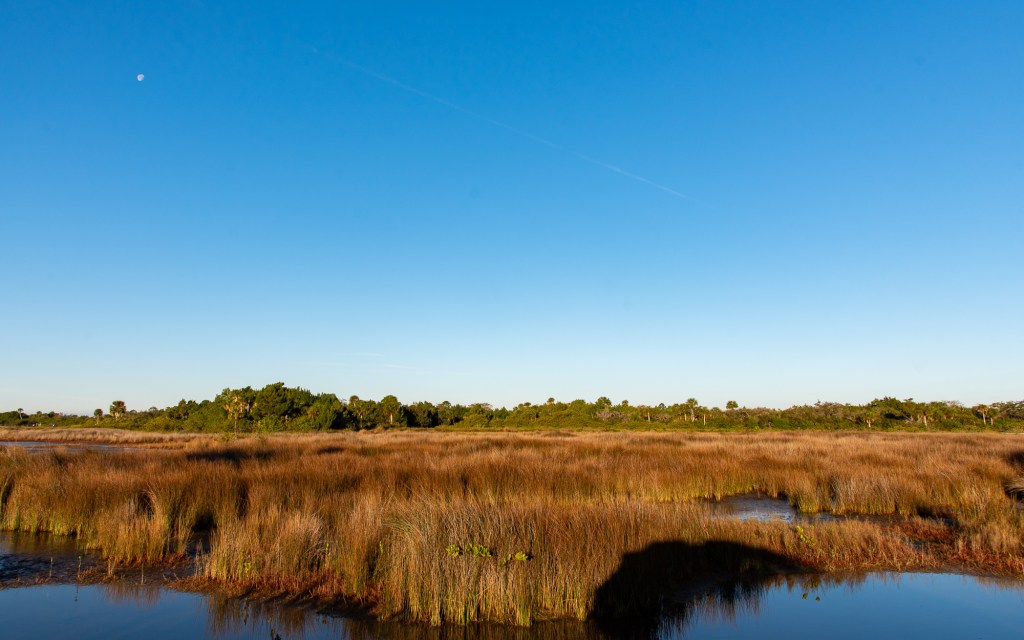
A Great Egret reflecting on what to have for breakfast.

This adult Little Blue Heron found a snack. Seems like it would take a lot of snacks that size to satisfy an appetite.

The Glossy Ibis uses its uniquely shaped bill to probe soft mud for delicious delicacies. Yum!

Try to get a portrait of a Snowy Egret and you get photo bombed by a Little Blue Heron.
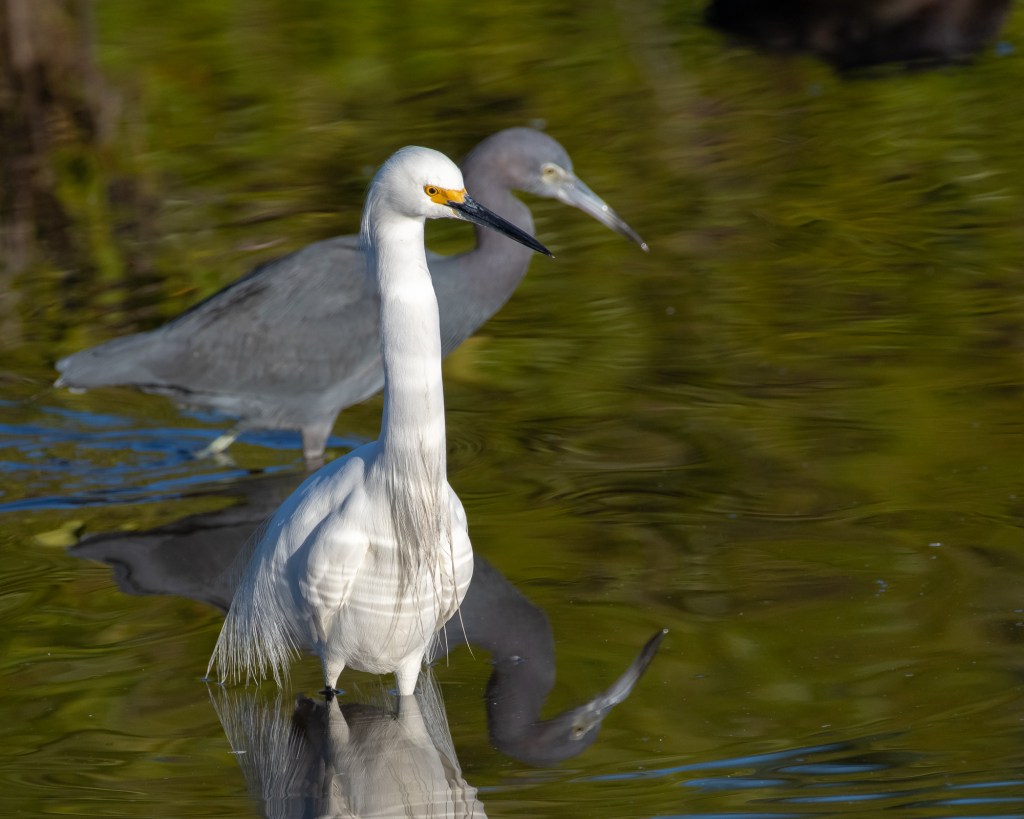
Second try for the Snowy Egret was successful and even managed a bit of a display of its namesake “aigrettes“. Spring is near.
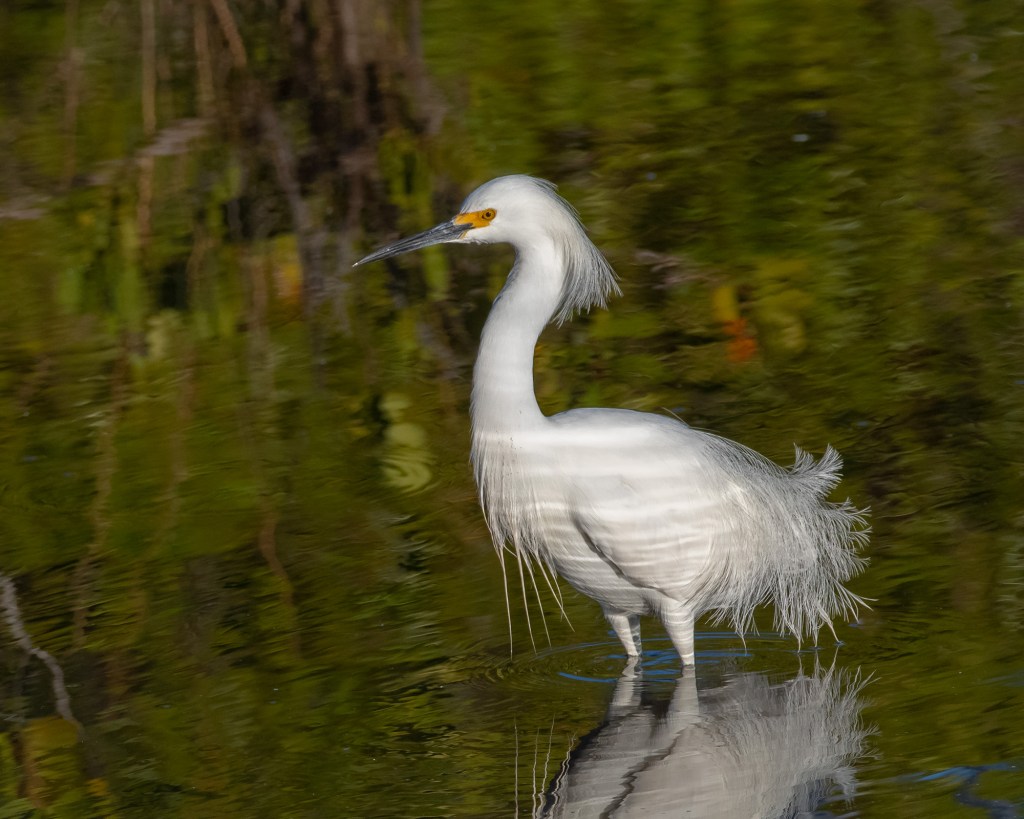
Ol’ Blue Eyes. White Ibises numbered in the hundreds throughout the day.
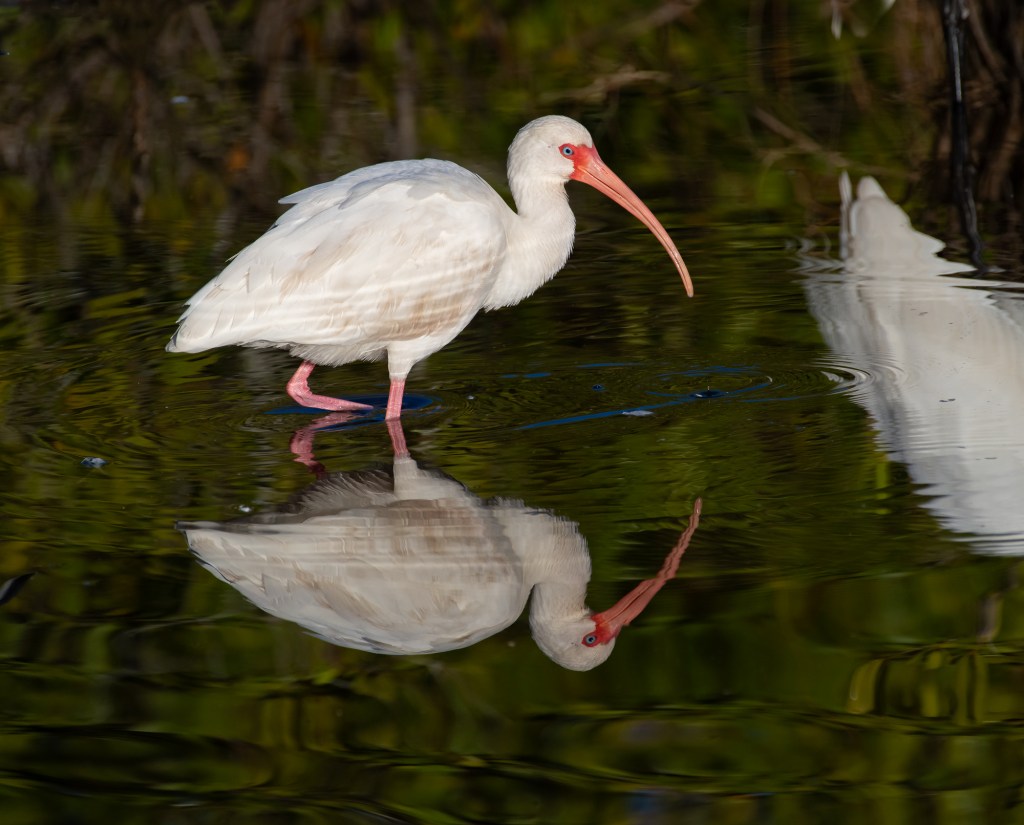
Winter migration offers a chance to see the Bonaparte’s Gull. They are small and almost resemble terns more than gulls. Unlike most gulls, they nest in trees. They are named for a fellow who contributed quite a bit to North American bird studies, Charles Lucien Bonaparte, a cousin of some sort of general with the same last name.


Immature Little Blue Herons remain mostly white during their first year, develop patches of slate-gray and by their second year achieve the solid color of an adult. Fish – it’s what’s for breakfast.
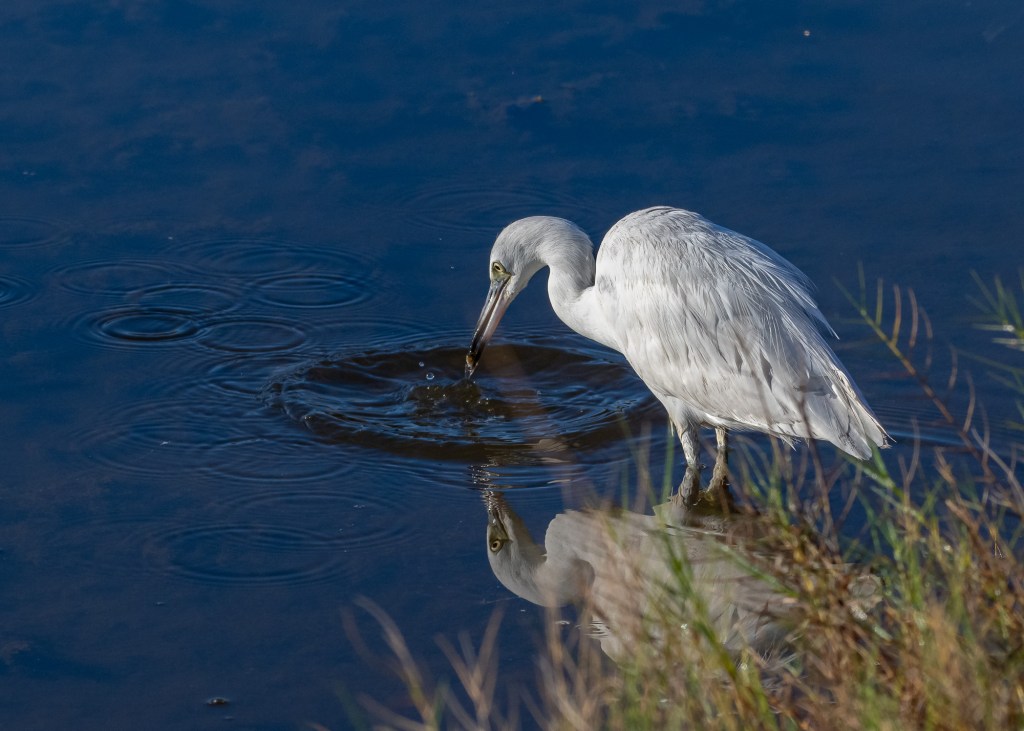
Dozens of Osprey dropped from the sky to snag fish wherever there was water.

We have made it to the half-way point of the wildlife drive. The sheer number of birds has been amazing. Up next: Marsh Madness.
Enjoy your search for a natural place and come back for a visit!
*https://www.fws.gov/refuge/merritt-island
Seeing so many different long-legged wading birds on the same day and in the same place is an absolute dream for me, while it was a reality for you. Thank you for letting me see them vicariously.
LikeLike
We will continue and try to feed your voracious vicariousness.
It’s a dirty job, but we don’t mind. At all. Really.
That place is a dream for us as well, Tanja. Hope we have that dream again soon.
LikeLiked by 1 person
Thank you for feeding me, Wally. I fear, thought, that my hunger will never be sated. I hope you can continue to live that dream, but I have to admit to being very, very envious.
LikeLike
I was there last Friday – It is a wonderful time of year to visit! Looking forward to the rest of your story!
LikeLike
Was hoping to emulate some of your outstanding sunrise landscapes, Ed. Alas, wind and location did not cooperate. Not to mention the poor quality photgrapher I hired.
Great birdy day, though!
LikeLiked by 1 person
Your sunrise shots are great Wally! You did a wonderful job working with what nature provided that morning.
Friday was an above average sunrise day – some nice clouds and calm water. Birding was good then too. I spotted several that I don’t normally see. I just need to get around to writing about my visit.
LikeLike
Beautiful shots of the sunrise. Looks like a fun place. One of these days I will get over there.
LikeLike
Thanks, Dina.
There is a lot to explore out there. October-April has the most bird variety, but it’s pretty neat any time.
LikeLike
Ah, another great adventure, out in the fresh air. Two of your early morning (45F) shots (Great Egret Reflecting and Little Blue Snack) show what appears to be a touch of frost on the tiny plants sticking out of the water. Is that what it was… or was it just the highly reflective dampness?
I’ve seen fields of orange-red Gaillardia down here, but I’ve never seen the bright pink body that your blossom seems to have. Beautiful!
Looking forward to Parts 2 and 3!!
LikeLike
Thank you, Sam.
Some of those plants had whitish/dead tips which may be what you’re seeing. Also, the angle of the sun could certainly cause that effect.
Next chapters arriving before Christmas. Maybe.
LikeLike
Absolutely fabulous shots! The non-bombed Egret is my favorite from this set, but then again, all the texture in the shot with the little blue in the water with the snack …tough call! I did not know the Bonaparte’s Gulls nested in trees – new knowledge for the grey matter. For the record, they are my favorite gull – sooo cute and I find far less annoying than the rest of their kin. Sounds like a wonderful place, can’t wait to see the remaining posts.
LikeLike
It’s a superb place to explore. Marsh, beach, rivers, creeks, pine woods, mixed woods – and birds in all of it!
Next chapter soon.
LikeLiked by 1 person
Very nice Wally. I’ll have to add MINWR to my list of future birding/nature spots.
LikeLike
Thanks, Brad. It’s definitely worth a visit.
LikeLiked by 1 person
Somehow I had you located on the eastern side of the peninsula; your mention of a cross-state drive suggests otherwise. In any event, Merritt Island’s another glorious destination. The abundance of birds is remarkable. Hundreds of White Ibis? I hardly can imagine it.
Are the marshes there fresh or salt water? Your before and after photos make me think that spot, at least, was fresh; it looks just like drought-stricken ponds-turned-mud-flat around here. On the other hand, the salt water marshes held at least some water even through last summer’s drought, thanks in part to tidal flow. I remember just enough about Florida to wonder if your marshes have a third source of water: the springs or whatever that feed places like the Everglades. You may have written about that — I’ll take a look.
As striking as the photos of the Ibis and Snowy Egret are, I really like the one of the Snowy and the Little Blue. It reminded me of Robert Louis Stevenson’s poem, “I Have a Little Shadow.” In turn, that made me wonder if the Little Blues engage in commensal feeding with the egrets, in the same way that Ibis and Snowy Egrets will feed together.
Marsh madness? Place your bets here! (Is there a bracket?)
LikeLike
We live in Lakeland, about half-way between Tampa and Orlando. “West-Central Florida”. Theoretically, we can reach the Gulf of Mexico in about an hour and the Atlantic Ocean in about 90 minutes. Traffic – “Ay, there’s the rub.”
Throughout MINWR you can find fresh and salt water marshes. The Black Point Wildlife Drive is actually built atop an old dike built to contain fresh water levels in an attempt at mosquito control. Tides and winds frequently bring in brackish water from the adjacent Indian River, which helps immensely in adding rich nutrients to the area. Rainfall creates many freshwater pools. It all amounts to a grand buffet spot for resident and migrating birds.
Last year’s photo of the dry mud flats was due to about three inches less rainfall than normal. Last week’s photo of the same spot with water present is due to a more average level of rain.
I’m not sure about springs in that area and will try to find out.
Over 800 photos for the day’s visit gives you a hint at how many birds were there!
LikeLiked by 1 person
When we first started chatting, I may or may not have mentioned that I had an aunt and cousin who lived in Lakeland. My cousin was a nurse; she worked at the hospital in Bartow. In fact, the last long trip I took my mother on was to visit them in Lakeland. That was long enough ago that I didn’t have a camera, and had no interest at all in the natural beauty in the area. Silly, silly me.
LikeLiked by 1 person
Another very engaging narrative about your explorations. The sunrise shots are splendid, showing off the Venus Belt and the opposite horizon is no less interesting. Is that area subject to the tides, which might account for the varying water levels between visits?
LikeLike
Thank you, Ken.
The water levels in the marsh are affected by the tides of the adjacent Indian River somewhat, but mostly by rainfall. This winter, Brevard County has had nearly three inches more rain than last year.
Great spot!
LikeLike
Just loved seeing these photos, Wally! Amazing reflections and beautiful lighting. I’ve never been to this refuge and have wanted to go. Cannot wait to see Parts 2 and 3!
LikeLike
Thank you, Donna. It’s a neat place to get lost in. If you have a chance, set aside a couple of days, at least.
LikeLiked by 1 person
So many wonderful wetland birds, Wally, and all superbly photographed too. The ‘turn around’ shot is beautiful, with the light being magical – I can almost imagine those stones standing up and heading into the water.
I reckon that your temperatures that day were colder than we had here – I think that we were at about 9°c that day.
I’m looking forward to Pt.2 !
My best wishes to you and Gini – – – Richard
LikeLike
There truly were a multitude of birds all around the refuge. Trigger-happy me tallied over 800 images before the sun set. Don’t panic. I won’t force you to view quite that number!
The wind died down about noon and the temperature reached 75 F/24 C about the same time. Typical Florida winter day! Need heaters in the morning and air conditioning by lunch.
Sunny wishes for both you and Lindsay.
LikeLike
Gallinules and gulls gabbling: the going was good.
That’s a nice ibis reflection, and a lovely portrait of the egret (by itself).
I’ve not heard of Bonaparte’s gull but have heard of Bonaparte’s retreat. That’s what he ended up doing after he was gulled into invading Russia.
Our Indian blankets—the same species—aren’t due in central Texas for another month or two, though there can be occasional prodigies.
Your comparison pictures seem to indicate you’re currently in a drought, unless something else accounts for the lack of water.
Your turnaround sunrise picture is pleasant. The advice to children to look both ways before crossing the street works for nature photographers, too (minus the street).
LikeLike
The day was filled with gabbling and the going was good, indeed.
Numerous pools within the marshes provide nice spots for reflection portraits as long as the models show up.
There were quite a few Indian Blankets in bloom but I’m fairly certain they blossom year round to some degree.
The comparison photos show the current condition – wet as opposed to last year’s dry situation. We’ve had a bit more rain this winter than last which I think accounts for the difference.
Looking both (all) directions is good advice for children, photographers, birders and most life forms.
LikeLike
Oops, I see I reversed the times in that pair of wet~dry views. If only we could turn a parched land into a watered one so easily.
As for getting models to show up, maybe paying them well above the minimum wage would do the trick.
LikeLiked by 1 person
5c and stiff wind….. welcome to my world.
Super images as per usual but the LBH with it’s snack is my favourite with the great reflection.
Question, on these ‘wildlife drives’ are there plenty of places to stop and explore or do you have to stay in your car?
LikeLike
Thanks, Brian.
This drive has several pull-off points and one can walk around a bit, but the car offers a great blind and many of the birds are very close in.
Additionally, there are a couple of trails of varying lengths, the longest about five miles, which offer great viewing opportunites.
LikeLike